外研版(2019)必修第一册Unit 6 At one with nature Understanding ideas(33张PPT)
文档属性
| 名称 | 外研版(2019)必修第一册Unit 6 At one with nature Understanding ideas(33张PPT) |  | |
| 格式 | zip | ||
| 文件大小 | 27.7MB | ||
| 资源类型 | 教案 | ||
| 版本资源 | 外研版(2019) | ||
| 科目 | 英语 | ||
| 更新时间 | 2022-07-11 15:00:09 | ||
图片预览

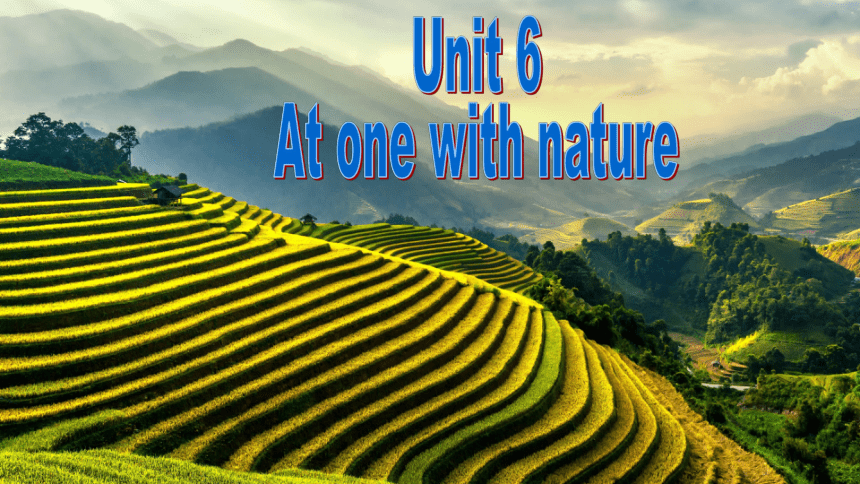
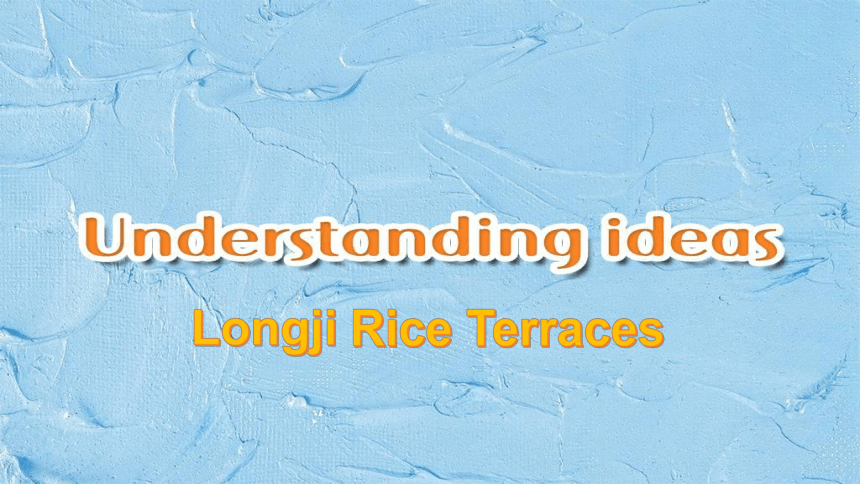

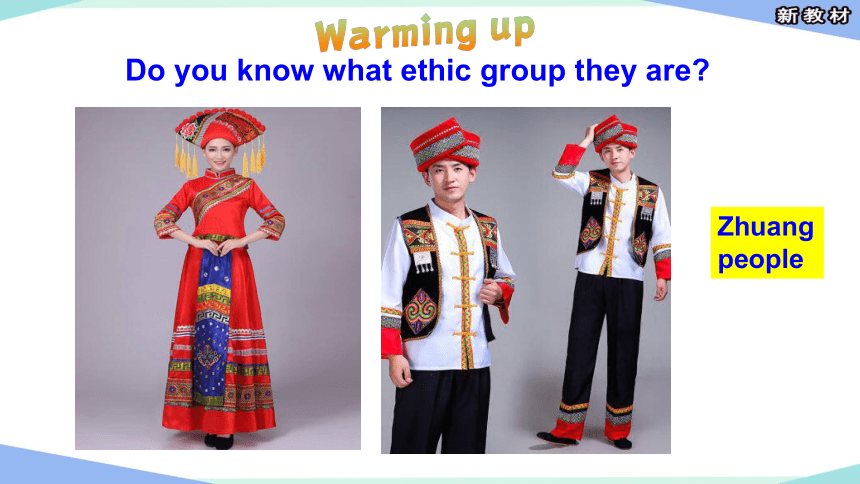

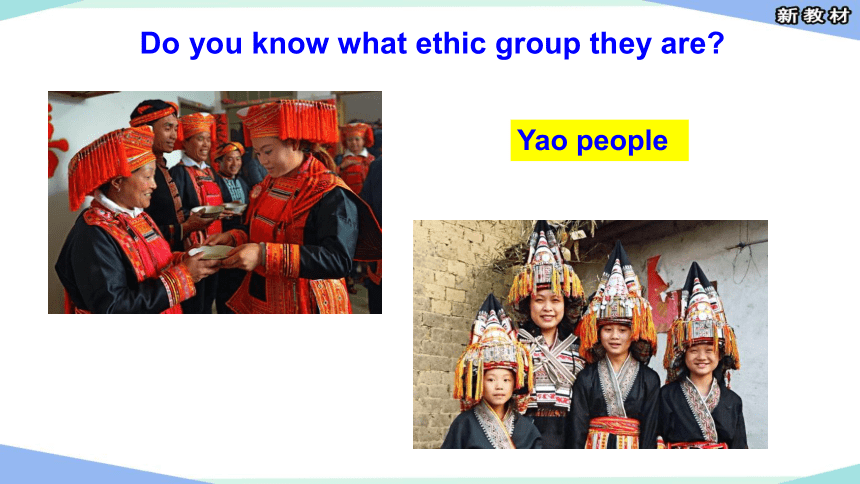
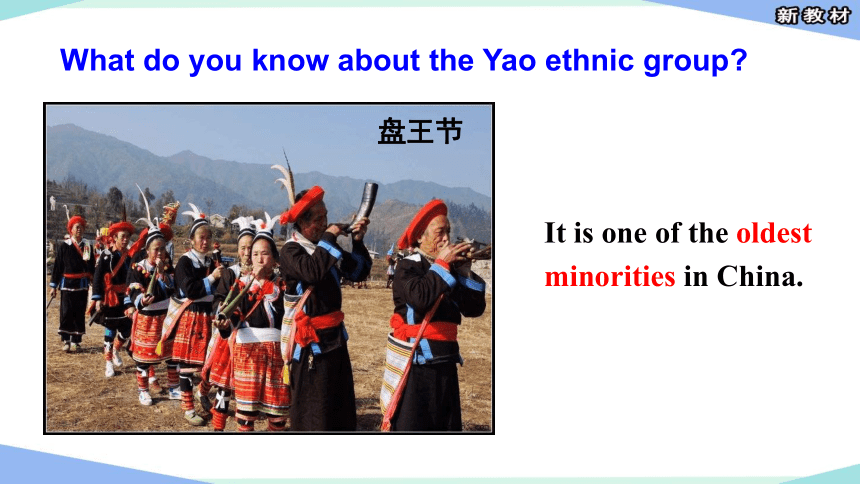

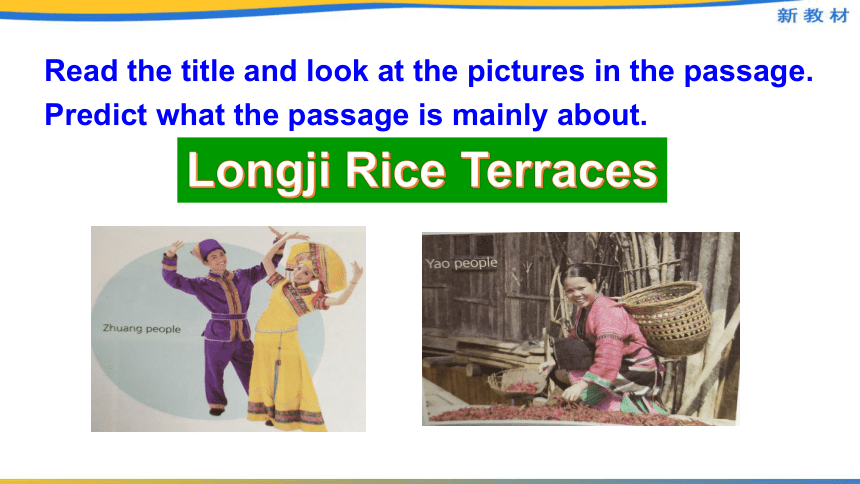

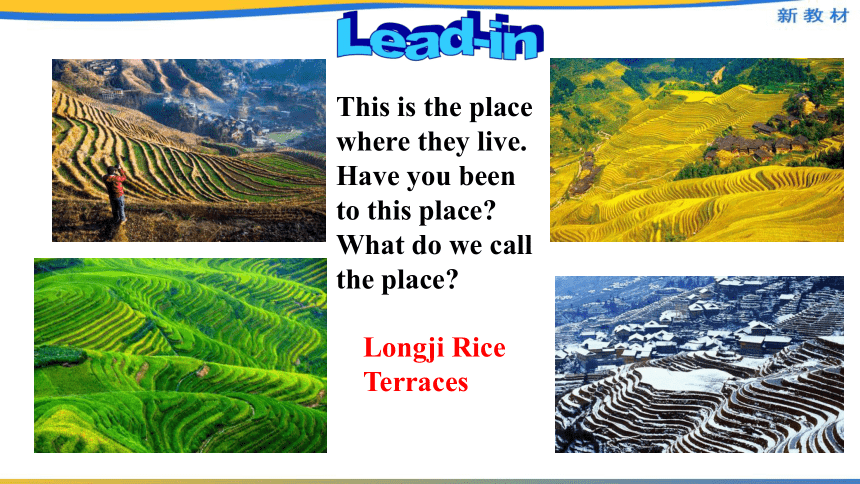
文档简介
(共33张PPT)
Unit 6
Unit 6
At one with nature
Longji Rice Terraces
To learn the background information about Longji rice terraces
To understand the main idea of the passage and analyse the author’s writing purpose
To understand the importance of the harmonious relationship between human beings and nature
Do you know what ethic group they are
Zhuang
people
What do you know about the Zhuang ethnic group
It may be the largest minority in China.
Do you know what ethic group they are
Yao people
What do you know about the Yao ethnic group
盘王节
It is one of the oldest minorities in China.
Read the title and look at the pictures in the passage. Predict what the passage is mainly about.
Longji Rice Terraces
Look at the pictures and talk about what you know about the Zhuang and Yao ethnic groups.
This is the place where they live.
Have you been to this place
What do we call the place
Longji Rice
Terraces
Lead-in
The Longji Rice Terraces are located in Longsheng County, about 100 kilometres from Guilin, Guangxi. The terraces are built on the slopes that rise up from the river to the top of the mountains. The terraces got the name because they look like a dragon’s scales, while the mountain ridge looks like its backbone.
Background information
Watch the video about Longji rice terraces.
How do they grow rice
Why do they grow rice on terraces
Read the passage and find out what problems the local people solved by working with nature.
Two problems are solved. The first one is that there are few large, flat areas of land in the region for people to grow rice. The other one is that the mountains are steep and the soil is shallow.
Longji Rice Terraces
Choose the author’s purpose in writing the passage.
1. To praise the wisdom of the ethnic groups living in Guangxi Zhuang Autonomous Region.
2. To explain how people worked in harmony with nature to create the Longji Rice Terraces.
3. To describe the beauty of the Longji Rice Terraces and to attract visitors to this scenic spot.
Listen to the passage and choose the main idea of each paragraph.
History of the Longji Rice Terraces
Colour of the Longji Rice Terraces
Purpose of building the Longji Rice Terraces
Significance of the Longji Rice Terraces
Today’s value of the Longji Rice Terraces
Colour
History
Purpose
Significance
Today’s value
本文是说明文(Exposition)
An exposition is a writing whose purpose is to give information.
1. What are the colours of the Longji Rice Terraces
2. Who built the terraces When were the terraces firstly built
The Longji Rice Terraces have different colours in different seasons. They are silver, bright green, gold and white.
The terraces were built by the local Zhuang and Yao people. The terraces were firstly built in the Yuan Dynasty.
Read the passage carefully and answer the questions.
3. Why did these people go to so much trouble to turn the entire mountains into terraces
Firstly, there are few large, flat areas of land in the region. Secondly, although the region has plenty of rain, the mountains are steep and the soil is shallow.
4. How have people worked to make these terraces and grow rice
People have worked in harmony with nature to make these terraces and grow rice.
Match the information with its supporting examples/details.
1. The terraces have different colours in different seasons. A. It started in the Yuan Dynasty and finished in the early Qing Dynasty.
2. The building of the terraces took many years. B. They formed a circle of climate.
3. The terraces cover a large area. C. The young people continue to use the terraces now.
4. The terraces are cleverly designed. D. They are covered in white in winter.
5. The local people still think highly of the terraces today. E. They extend as far as the eye can see.
1-D 2-A 3-E 4-B 5-C
Read the summary of the passage and correct four factual mistakes.
The Longji Rice Terraces were built by the local Zhuang ethnic group alone. Though there are many large, flat areas in the region, they built terraces on the mountains to have more areas to grow rice. The terraces are cleverly designed, and can wash away the shallow soil.
Zhuang and Yao people.
Since
there are few large,
hold
There are hundreds of waterways, along which rainwater moves down the mountains and into the terraces. Today, local people use modern methods to maintain the terraces, and they attract lots of visitors from all over the country.
ancient methods of agriculture to
Read the passage again and find out the working principle of the Longji Rice Terraces. Then use the picture to retell it in your own words.
vapour
rain
sun
water
cloud
During the rainy season, rainwater moves down the mountains along hundreds of waterways that connect with
each other and the terraces. The sun heats the water and turns it into vapour. This forms clouds from which rain falls down onto the mountain terraces once again.
Why do the local people still keep their traditional way of growing rice
Because the knowledge is passed down through generations of families, and it suits the natural environment.
2. In what other ways do people live in harmony with nature Give examples.
People plant trees and protect forests to protect themselves from environmental problems like sandstorms and global warming.
What can we do as a student to help live in harmony with nature
We can recycle our stationery, save paper and take public transportation instead of driving private cars.
…
Write a short summary about 100 words based on Longji Rice Terraces. Try to use as many new words and key expressions as you can.
Preview the next part: Using language
Unit 6
Unit 6
At one with nature
Longji Rice Terraces
To learn the background information about Longji rice terraces
To understand the main idea of the passage and analyse the author’s writing purpose
To understand the importance of the harmonious relationship between human beings and nature
Do you know what ethic group they are
Zhuang
people
What do you know about the Zhuang ethnic group
It may be the largest minority in China.
Do you know what ethic group they are
Yao people
What do you know about the Yao ethnic group
盘王节
It is one of the oldest minorities in China.
Read the title and look at the pictures in the passage. Predict what the passage is mainly about.
Longji Rice Terraces
Look at the pictures and talk about what you know about the Zhuang and Yao ethnic groups.
This is the place where they live.
Have you been to this place
What do we call the place
Longji Rice
Terraces
Lead-in
The Longji Rice Terraces are located in Longsheng County, about 100 kilometres from Guilin, Guangxi. The terraces are built on the slopes that rise up from the river to the top of the mountains. The terraces got the name because they look like a dragon’s scales, while the mountain ridge looks like its backbone.
Background information
Watch the video about Longji rice terraces.
How do they grow rice
Why do they grow rice on terraces
Read the passage and find out what problems the local people solved by working with nature.
Two problems are solved. The first one is that there are few large, flat areas of land in the region for people to grow rice. The other one is that the mountains are steep and the soil is shallow.
Longji Rice Terraces
Choose the author’s purpose in writing the passage.
1. To praise the wisdom of the ethnic groups living in Guangxi Zhuang Autonomous Region.
2. To explain how people worked in harmony with nature to create the Longji Rice Terraces.
3. To describe the beauty of the Longji Rice Terraces and to attract visitors to this scenic spot.
Listen to the passage and choose the main idea of each paragraph.
History of the Longji Rice Terraces
Colour of the Longji Rice Terraces
Purpose of building the Longji Rice Terraces
Significance of the Longji Rice Terraces
Today’s value of the Longji Rice Terraces
Colour
History
Purpose
Significance
Today’s value
本文是说明文(Exposition)
An exposition is a writing whose purpose is to give information.
1. What are the colours of the Longji Rice Terraces
2. Who built the terraces When were the terraces firstly built
The Longji Rice Terraces have different colours in different seasons. They are silver, bright green, gold and white.
The terraces were built by the local Zhuang and Yao people. The terraces were firstly built in the Yuan Dynasty.
Read the passage carefully and answer the questions.
3. Why did these people go to so much trouble to turn the entire mountains into terraces
Firstly, there are few large, flat areas of land in the region. Secondly, although the region has plenty of rain, the mountains are steep and the soil is shallow.
4. How have people worked to make these terraces and grow rice
People have worked in harmony with nature to make these terraces and grow rice.
Match the information with its supporting examples/details.
1. The terraces have different colours in different seasons. A. It started in the Yuan Dynasty and finished in the early Qing Dynasty.
2. The building of the terraces took many years. B. They formed a circle of climate.
3. The terraces cover a large area. C. The young people continue to use the terraces now.
4. The terraces are cleverly designed. D. They are covered in white in winter.
5. The local people still think highly of the terraces today. E. They extend as far as the eye can see.
1-D 2-A 3-E 4-B 5-C
Read the summary of the passage and correct four factual mistakes.
The Longji Rice Terraces were built by the local Zhuang ethnic group alone. Though there are many large, flat areas in the region, they built terraces on the mountains to have more areas to grow rice. The terraces are cleverly designed, and can wash away the shallow soil.
Zhuang and Yao people.
Since
there are few large,
hold
There are hundreds of waterways, along which rainwater moves down the mountains and into the terraces. Today, local people use modern methods to maintain the terraces, and they attract lots of visitors from all over the country.
ancient methods of agriculture to
Read the passage again and find out the working principle of the Longji Rice Terraces. Then use the picture to retell it in your own words.
vapour
rain
sun
water
cloud
During the rainy season, rainwater moves down the mountains along hundreds of waterways that connect with
each other and the terraces. The sun heats the water and turns it into vapour. This forms clouds from which rain falls down onto the mountain terraces once again.
Why do the local people still keep their traditional way of growing rice
Because the knowledge is passed down through generations of families, and it suits the natural environment.
2. In what other ways do people live in harmony with nature Give examples.
People plant trees and protect forests to protect themselves from environmental problems like sandstorms and global warming.
What can we do as a student to help live in harmony with nature
We can recycle our stationery, save paper and take public transportation instead of driving private cars.
…
Write a short summary about 100 words based on Longji Rice Terraces. Try to use as many new words and key expressions as you can.
Preview the next part: Using language
